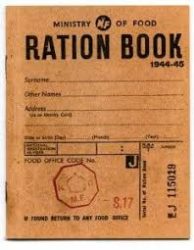WW2 Rationing Rules
As we mark the end of WW2 in Europe in 1945, it’s worth reflecting on the tough rationing that continued in Britain for another 9 years. Unlocking Warwick’s Barbara Wigmore recently unearthed a booklet listing the rules as they were introduced and then later as they were relaxed.
 Foods were placed on ration gradually:
Foods were placed on ration gradually:
1940. January – bacon, ham, sugar and butter were placed on ration. March – meat. July – tea, margarine, cooking fat and cheese.
1941. March – jam, marmalade, treacle and syrup. June – distribution of eggs controlled. November – distribution of milk controlled.
1942. July – sweets on ration.
Basic rations for one person per week were: Meat – 4oz of bacon or ham. Other meat to the value of 1 shilling and tuppence. (Corned beef and Spam were part of the points system). Dairy Products – 2oz butter, 4oz margarine, 4oz cooking fat, 2oz cheese, 3 pints of milk supplemented in December 1941 with dried milk – a tin every 4 weeks. Sugar – 9oz. Eggs – 1 shell-egg every two weeks (with dried egg available from June 1942). Tea – 2oz.
In Warwick, food retailers had to obtain licences from the Court House. A committee based at 22 Northgate Street addressed the problem of a shortage of vegetables. All areas of rough ground in the parks were planted with potatoes, and the council decided that grass verges should also be used for vegetables. Schoolboys were regularly excused lessons to go on potato-picking days. Many people with big enough gardens kept chickens or pigs; the court records show that there were plenty of BM (black market) offences to be dealt with.
Gwilym LLoyd-George as Minister of Food from 1951 to 1954 made de-rationing of food a priority, but even so sugar remained on ration until 1953, and butter, margarine, cooking fat, cheese, meat and bacon remained on ration until 1954, when ration books were no longer needed.


